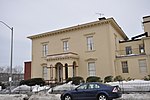Worcester Memorial Auditorium

Worcester Memorial Auditorium (also known simply as "the Aud") is a multi-purpose arena located at Lincoln Square in Worcester, Massachusetts. It was built in 1933 to honor the sacrifices of Worcester citizens during times of war. The building includes a multi-purpose auditorium originally designed to seat 3,500-4,500 people, a smaller entertainment space known as the Little Theater designed to seat 675, and the Shrine of the Immortal, a war memorial with murals by renowned artist Leon Kroll commemorating the 355 soldiers and nurses from Worcester who fell during World War I. The Aud was added to the National Register of Historic Places in 1980 as part of the Institutional District. In 2009, Preservation Massachusetts included Lincoln Square on its "Most Endangered Historic Resources" list, because the square's three historic buildings - the Aud, the old Worcester County Courthouse, and the Lincoln Square Boys Club - were all empty or underutilized. In 2016, the City of Worcester engaged the Boston-based Architectural Heritage Foundation (AHF) to conduct a feasibility study of the Aud. AHF submitted its final report in February 2019, which recommended that the building become a center for digital innovation, entertainment, entrepreneurship, and the arts. Discussions between AHF and the City are ongoing.
Excerpt from the Wikipedia article Worcester Memorial Auditorium (License: CC BY-SA 3.0, Authors, Images).Worcester Memorial Auditorium
Lincoln Street, Worcester
Geographical coordinates (GPS) Address External links Nearby Places Show on map
Geographical coordinates (GPS)
| Latitude | Longitude |
|---|---|
| N 42.27176 ° | E -71.800965 ° |
Address
Worcester Memorial Auditorium
Lincoln Street 1
01605 Worcester
Massachusetts, United States
Open on Google Maps











